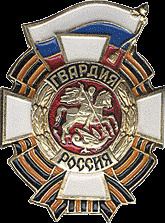 | ||
Similar | ||
Guards (Russian: гвардия) or Guards units (Russian: гвардейские части, gvardeyskiye chasti) were elite military units of Imperial Russia prior to 1917-18. The designation of Guards was subsequently adopted as a distinction for various units and formations of the Soviet Union and the modern Russian Federation. The tradition goes back to the a chieftain's druzhina of medieval Kievan Rus' and the Marksman Troops (Стрелецкое Войско), the Muscovite harquebusiers formed by Ivan the Terrible by 1550. The exact meaning of the term "Guards" varied over time.
Contents
Imperial Russian Guard
In the Russian Empire, Imperial Russian Guard units (also lifguard or life-guard, лейб-гвардия, leyb-gvardiya), derived from German Leibgarde (en: lifeguard or life-guard), were intended to ensure the security of the sovereign, initially, that of Peter the Great in the 1690s. These were based on the Prussian Royal Life Guards. During the 19th century the Imperial Russian Guard regiments were not exclusively composed of Russian troops, but also included Lithuanian, Finnish and Ukrainian units.
At the beginning of the 20th century, the Imperial Guards consisted of 13 infantry, 4 rifles and 14 cavalry regiments, artillery, engineers and transport, making up a separate entity within the army of three divisions. During the Brusilov Offensive the 1st and 2nd Guards' numbers were supplemented with line army corp and from September 1916 were known as the 'Special Army'.
In February–March 1917 the defection of reserve battalions of the Imperial Guard based in Petrograd was a major factor in the overthrow of the Tsarist government. The service units of the Guard at the front disintegrated along with the remainder of the Imperial Army, until it was formally replaced by the new Red Army on 28 January 1918.
Russian Revolution
The Red Guards (Russian: Krasnaya Gvardiya) were armed groups of workers formed during the Russian Revolution of 1917, although the designation and concept dates back to Moscow during the Revolution of 1905. In 1917 the volunteers of the Red Guard and their elected leaders formed the main strike force of the Bolsheviks. These workers' militias were created in March 1917 in by Factory and Plant Committees and by Bolshevik party cells, with the initial purpose of defending the industrial enterprises and districts where they were recruited. In October 1917 the Red Guards of Petrograd played a leading role in the capture of the Winter Palace and the overthrow of the Provisional Government. When the Soviet Red Army was formed in 1918, the Red Guards became the Army Reserve and the basis for the formation of regular military detachments.
The White Guard (Russian: Belaya Gvardiya) or White Army (Belaya Armiya, whose members were called belogvardeytsy), comprised both the political and military forces of the Russian White Movement, which opposed the Bolsheviks after the October Revolution and fought against the Red Army during the Russian Civil War from 1918 to 1921.
Soviet Guards
The Guards units (Russian: Гвардия, Gvardiya) were again awarded to units and formations that distinguished themselves during the Second World War by the order of People's Commissar for Defence of USSR No.303 on the 18 September 1941, and were considered to have elite status. However, the Guards badge was not introduced until 21 May 1943.
Zhukov states "the first period of the war gave birth to the Soviet Guards. For mass heroism and success in the battles of 1941-1942 the Guards title was awarded to 789 groups, formations, separate units, and fighting ships of the Soviet Armed Forces."
There were total 11 Guard Armies and 6 Guard Tank Armies:
Russian Federation Guards
The Guards distinction was retained as designations of units and formations in the armed forces of the former Soviet Union: Russia, Belarus, and Ukraine.
